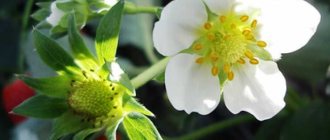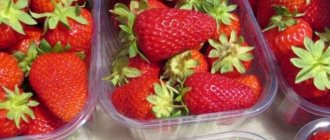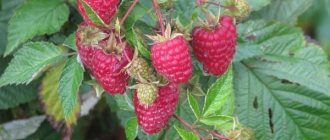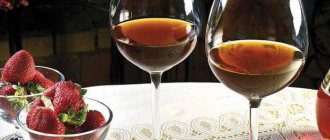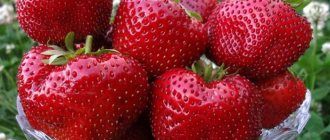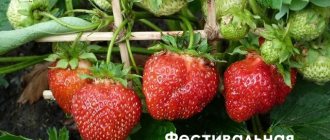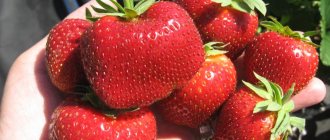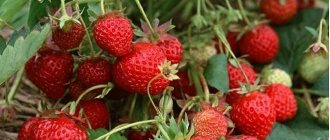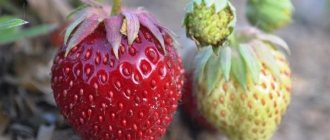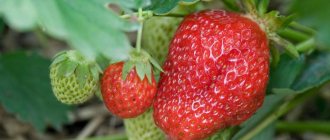Description and characteristics
The variety "Florian F1" is unique in its kind, combining excellent quality characteristics of berries and consistently high yields. Remontant large-fruited strawberries of early ripening, when cultivated in a fertile area and high agricultural technology, produce a yield of up to 1 kg per bush.
This hybrid form forms fairly compact plants with a height of no more than 30 cm and a diameter of about 35 cm. When grown in protected soil, immediately after planting, strawberry bushes enter the phase of active development and begin to form a crop, regardless of weather conditions and time of year. The average weight of a commercial berry is 18 g. The pulp of the fruit is tasty, relatively dense, sweet with slight sourness.
Characteristics of the berry
“Florina” berries pleasantly surprise with their considerable size and impressive weight for strawberries - from 40 to 80 grams each. The shape of the fruit is conical (cone-shaped), the structure of the pulp is dense, the color is bright, scarlet and red.
The berries have a unique taste ; experts characterize it as sweet with a slight sourness, very delicate and subtle. The real, pronounced strawberry aroma is also attractive. The fruits have a glossy shine.
The peculiarity of the variety is that the berries of each new harvest do not become smaller than the first fruits. And this is the difference from most large-fruited species.
It begins to bear fruit at the same time as other early-ripening species, and the formation of berries is completed only in late autumn.
Landing Features
Strawberries of the hybrid form "Florian F1" need good lighting and sufficient moisture in the planting area. It can be grown by both seed and seedling methods.
Sowing of stratified seed material is carried out around February-March - superficially, in well-moistened fertile soil. Then the seedling container is covered and until the strawberry shoots appear, the soil moisture is monitored, periodically spraying it with warm water from a spray bottle. After 2-3 true leaves appear on the seedlings, the seedlings are planted into separate planting containers.
Strawberry seedlings are planted on ridges in open ground in the spring, after the threat of return frosts has passed.
The area for growing garden strawberries should be level, cleared of weeds, without significant shading or waterlogging, with loose, well-aerated and fertile soil with neutral acidity.
When planting, the distance between rows should be 25-30 cm, and between strawberry bushes - at least 15 cm. It is important to control the depth of the plant’s immersion in the soil: you cannot bury the “heart”, but placing it too high is undesirable, because can cause the plant to dry out and die.
Landing
Strawberry Florina loves loose soil with a neutral or slightly acidic reaction. If the soil is sufficiently acidic, it is necessary to lime the area using dolomite flour or ash.
A well-lit place with deep groundwater is chosen. Nightshade crops are bad predecessors for strawberries; it is best to plant the berries after green manure, peas, onions, and garlic.
It is necessary to prepare the soil a month before the planned date of planting seedlings. The area is dug up and fertilized.
You can start planting in early spring:
- The roots of the seedlings are placed in a solution of any root formation stimulator, for example, in Kornevin, per day.
- At the site, holes are prepared at a distance of 30 cm from each other in a line or two-line method.
- In the evening, the prepared bushes are planted and dug in so that the heart remains at ground level.
- The beds are watered and mulched with a layer of peat or sawdust.
The main key to successful planting is the use of high-quality seedlings.
Care instructions
Growing garden strawberries of the “Florian F1” variety is quite easy: they are unpretentious, adapt well, and do not reduce yields if agricultural technology is insufficient. Gardeners just need to follow simple standard recommendations for caring for strawberry plantings:
- irrigate at all stages of the growing season with warm water at the roots, calculating the number and volume of watering based on the level of soil moisture;
- immediately after watering, at least five times a season, fertilize the plants with organic and mineral fertilizers, giving preference to environmentally friendly ones: a solution based on bird droppings, liquid mullein and herbal infusion;
- closely monitor the health of plants and carry out preventive spraying with effective insecticidal and fungicidal preparations several times during the active growing season;
- systematically weed, thoroughly loosen and plant plants;
- to obtain the cleanest possible harvest, mulch the soil around the strawberry bushes with hay, straw or special garden film;
- Pick berries as they ripen, at least twice a week.
Planting Tips
Planting Florina is a simple matter if you choose the right soil. Chernozem or loamy soils are considered ideal. However, Florina will also take root in soil purchased from a specialty store. To achieve the best quality harvest, it is worth remembering the following tips from summer residents:
- The more competently the area for planting is chosen, the better the harvest will be. Solanaceous crops should be avoided as predecessors. Mustard, garlic and onions are considered ideal precursors for the berry.
- Florina will ideally take root on a plot of land with good natural light. Soil acidity levels should be average or close to low. A non-wetland area with black soil, loamy and sandy loam soil is best suited.
- The ideal time to plant Florina is either cloudy weather or cool evening hours. Before planting the tuber plant, it is important to keep it in a cool, dark room for several days.
- When planting a variety in holes, you should monitor the placement of the root system. If necessary, help the strawberries straighten them, being careful not to damage them.
After the planting process, standard watering of the beds and mulching by any method takes place.
Strawberry Florian F1 from seeds
Chance meeting in a supermarket
We met Florian F1 at the Stroygiant store. This was in December 2021. The supermarket had not yet had time to put out the new seeds, and I had already come for them. I didn’t plan to buy strawberry seeds, because I didn’t know that they were even sold.
And suddenly I see: strawberries Florian F1, remontant, 5 pieces. They cost 65 rubles. Agro. I tried to buy all the seeds from this particular company, since they did not disappoint last season. Now I am not so categorical, I have found other good companies for myself.
Just curious: I read that Florian F1 is a strawberry from a Dutch breeding plant, but I thought that “AELITA” received a hybrid. There is something I still don’t understand... And Gavrish sells it. You have to understand that Dutch seeds are packaged.
So, Florian F1 is my first strawberry from seed. In June she was gorgeous, but now, at the end of August, she is so smart:
Photo from August 29, 2021. It’s +11°C outside after the heat and rain.
Photo dated August 30, 2021.
And this is what Florian F1 looks like on an Agro bag:
It's a shame we didn't photograph Florian's first flower. It was large, an unusual pale pink color, but not nearly the same as in the picture. It seemed to me then that he was more beautiful than any rose! I was very pleased. Then it turned white, and all the flowers quickly turned white.
In May I had the feeling that I would no longer grow strawberries from seeds, there was too much worry. But that pink flower! Those raging leaves! The joy prevailed. Will!
The breeders' idea doesn't seem to have been fully realized, but I like it! Perhaps the soil is different, it affects the color of the flowers.
According to the plan, what came true:
- Large bright red berries, individual up to 20 g, with dense pulp, very sweet and aromatic.
- The yield was promised on good soil up to 1 kg per bush, but I did not check it. There are a lot of berries, and by autumn they have become significantly smaller.
According to the plan, which did not quite come true:
- Continuous fruiting from May to October. There was a short break.
- The soft pink flowers turn white very quickly, and by autumn the flowers are initially white or with a hint of soft pink. And they should be quite pink.
- The berries are mostly elongated, not like in the picture. However, I saw a completely different picture with Florian F1, there are exactly the same berries as mine.
Landing not according to the rules
All tips for planting strawberry seeds boil down to shallow containers or peat tablets. But I really wanted strong bushes with long roots, and I planted Florian F1 in half-liter cups, each in a separate one. I'm lucky. The purchased soil, namely “Living Earth,” did not turn sour, the roots grew well to the bottom.
It was January 6th. Carefully placed the seeds on the surface. I organized a greenhouse + 25°C on a warm floor.
Four out of five seeds sprouted on January 22, 23 and 25. One container with a sprout fell first. Three left. I immediately put them on a cold windowsill, where it was +15°.
Under the cups there were pallets and... garden books... I had a classmate who put lectures under his pillow before the exam, maybe they diffused :). Well, I didn’t hope that the strawberry would learn anything, but it felt warmer with garden wisdom.
I watered from above, not always every day, sometimes the soil even remained moist for several days.
Backlight
Until February 18, I supplemented the light with a regular LED lamp, for lack of a better one. Then a mirror rack and a 15 W phytolamp appeared. It became like this:
Florian F1 in large glasses, she’s so small you can’t even see her, but she’s already three weeks old. That same evening, we cut off the shade of the table lamp, since it is impossible to create even such a small obstacle for the phytolamp, it overheats (there was no simple socket with a wire and a plug):
Description of the berry crop
The sources indicate this variety under consonant names: “arosa” and “arosa”. It was obtained in Italy and is the result of crossing Chandler and marmalade. Strawberries inherited the best characteristics from their ancestors.
Brief description of the variety: bright taste, extended fruiting period and resistance to fungal and viral infections.
The strawberry variety "Arosa" has the following characteristics:
- bushes of medium size, spreading leaves, light green, with pubescence along their edges and on the petioles;
- development is rapid;
- peduncles rise above the foliage, the inflorescences themselves are presented in the shape of a cup with a corolla;
- the intensity of whisker formation is average, they are enough for reproduction, but the grooming process is not burdened by their removal;
- the fruits are orange-red, shiny, round in shape (this can be seen in the photo), tiny seeds are noticeable on the surface;
- on average, the weight of the berry reaches 30-45 g;
- the first fruits are represented by a scallop (usually they are round).
Due to the fact that "arosa" ripens a little later than other varieties, it is often grown for commercial purposes. The culture meets the basic requirements, it is not watery, can be easily transported and can be stored for a long time. The main indicators are visible in the photo.
Interesting! At the stage of technical maturity, the tips of the berries are uncolored and white.
Description of the variety
Day-neutral strawberries (NDS) Florina are the result of the work of Dutch breeders. Over a very short period of existence, thanks to its remontability and versatility, the variety has gained great popularity among gardeners, including our compatriots.
Florina is characterized by compact bushes of medium size. Graceful shoots are densely covered with large leaf plates of light green color. Peduncles are powerful and erect. Whiskers are formed with medium intensity.
The shiny, light red berries are perfect not only for fresh consumption, but also for canning. They are sweet and very fragrant. The shape of the fruits is medium to large, wide-conical. The disadvantages include the low density of the berries and, as a result, mediocre transportability.
The large-fruited variety demonstrates consistently high yields. The weight of one berry with tender and dense pulp is 35-40 g. It is noteworthy that after the first harvest the fruits do not become smaller.
Advantages and disadvantages
The list of the main advantages of the variety can be presented as follows:
- high yield. From 100 acres they take up to 220 centners of berries per season with good care;
- the fruits are beautiful, dense, one-dimensional, but the advantage is not the appearance, but the taste;
- the berries are dense, durable, and can be transported over long distances;
- the variety can be grown in open and protected ground, even as a potted crop;
- Arosa strawberries are resistant to various diseases and pests;
- frost resistance is sufficient. In the southern regions of Russia with mild winters, shelter is not required.
Growing and care
Agricultural technology for growing berry gardens involves performing a number of mandatory activities.
Watering
Remontant Florina needs more frequent and abundant moisture compared to conventional varieties. Watering is especially important in the southern regions of Russia, where without proper moisture, bushes often fall out in hot weather.
Basic recommendations for watering:
- Only the planted seedlings are moistened daily, gradually increasing the interval. It is enough to water rooted bushes weekly.
- In the next season, the first watering is carried out at the end of April.
- During the growing season, adult plants are watered twice a month. With prolonged absence of precipitation, the frequency of the procedure increases.
- Work is carried out in the morning or evening with settled, warm water.
The optimal way to water strawberries is the drip method.
Loosening, weed control, mulching
To ensure the necessary soil parameters and preserve more nutrients, it is necessary to systematically loosen the soil and remove weeds. The latter depletes the soil and takes away the necessary substances from the berry grower. Loosening must be carried out after heavy rainfall or watering.
To save time, you can resort to mulching. A layer of mulch will prevent moisture from quickly evaporating and will also maintain the loose structure of the soil. You can mulch the beds with either organic materials or use agrofibre.
Removing a mustache
To get a harvest in the form of a large number of large berries, you should regularly remove the whiskers. The variety has moderate weeding, so the procedure will not take much time. To propagate the variety, it is better to leave several mother bushes in the garden from which the flower stalks are removed during the season. In this case, all the strength of the bushes will go towards the formation of new shoots.
Feeding and fertilizers
Before active growth begins, strawberry bushes are fed with nitrogen-containing fertilizers, which stimulate the growth of green mass. For this purpose, both organic matter (compost, chicken manure) and mineral components (ammonium nitrate, urea) are used.
Phosphorus-potassium complexes are added under the bushes during the flowering, fruiting and preparation for winter phases. In autumn, the beds can be shed with an aqueous solution of ash.
Pest and disease control
Despite good immunity to most diseases, in cool and rainy summers Florina is affected by fungal diseases such as powdery mildew and gray rot. The most effective means of protection are copper-containing preparations, for example, a solution of Bordeaux mixture. In addition, as a preventative measure, it is recommended to use similar solutions for spring treatment at the beginning of the growing season.
The main pests of strawberries are aphids and spider mites. They should be combated by spraying with an insecticidal agent according to the manufacturer's instructions indicated on the packaging. In this case, it is worth taking into account the toxicity period of the drug so that there is no pesticide residue in the harvested crop.
At high humidity, slugs also harm the crop. Gastropod pests will have to be combated mechanically by collecting them manually.
Preparing for winter
In order for strawberries to successfully overwinter, it is necessary to carry out a number of measures to prepare the bushes for the cold period. Pruning is carried out, during which the mustache, peduncles and damaged leaves are removed. The old mulch is removed, the bushes and the soil under them are sprayed for preventive purposes against harmful organisms. The soil is then re-mulched with fresh material.
In severe winter conditions, it is recommended to cover the berry garden with a layer of mulch of at least 8 cm. Use spruce spruce branches or non-woven material on top.
Features of planting and growing
It is better to plant young plants in open ground after the risk of return frosts has been eliminated, at the end of May. If you do this earlier, you will have to worry about additional organization of the shelter. Another option is to plant at the end of summer, before autumn, but the bushes must have time to take root.
You need to pay attention to the quality of the purchased seedlings. Each young bush should have at least 5 leaves. Inspect the root system; it should be massive. If a plant shows signs of any disease, it is discarded; planting next to healthy specimens will lead to infection of the latter.
Arosa bushes are compact but tall. They should be planted in one or two rows, depending on the characteristics of the summer cottage. The spacing between rows is 35-40 cm. At different stages of the growing season, the crop requires care.
In the spring, the gardener performs the following manipulations:
- immediately after removing the snow cover, clears the area under the strawberries, removes fallen leaves and burns them;
- when the strawberries come back from sleep, carefully examine the plantation, replace the dead plants with new ones;
- after drying the soil, it provides watering and loosening;
- carries out the first fertilizing, treatment against pests and diseases.
Fertilizers are applied 4 times per season. In the middle zone - at the end of April (when the snow cover melts), in May, June and September.
Features of cultivation
Since this hybrid is very demanding on growing conditions, in order to obtain stable and high yields, the gardener needs to take care of proper care of the strawberry plantation. Care requirements include: proper planting, watering, fertilizing, shelter for the winter, protection from spring frosts during flowering, mulching, prevention of diseases and pests, and timely harvesting of fruits.
Read more about how to grow strawberries in winter.
Selection of site and planting material
If the bed is located on fertile black soil, then the soil must be loosened in preparation for planting. If the soil is sandy and poor in organic matter, it should be fertilized with manure or compost (about 4-5 kg/m²). Before making a bed, it is necessary to remove weeds , especially wheatgrass and other perennial creeping weeds. Strawberries in the garden are best grown in a sunny place, in soil rich in humus, but light, even sandy, permeable to moisture and oxygen, slightly acidic (pH 5.5–6).
This crop will not grow well in heavy and wet soils. If the berries are grown in lowlands, then it is best to grow the crop in beds raised 15–20 cm above the ground so that water does not stagnate in the root zone of the plants. The best time to plant seedlings with an open root system is August-September.
Such seedlings will have time to fully take root before winter and will produce a good harvest next year. If strawberries were planted in the spring (April-May), then in the first year of cultivation the gardener cannot count on a large number of berries. Strawberry bushes produce the best harvest in the 2-3rd year of the growing season, so it is recommended to grow them in one place for only 3-4 years. Then the strawberry seedlings should be planted in a new place.
Important! To prevent the strawberry conveyor from being interrupted due to the old age of the bushes, the gardener is recommended to lay out a new bed every 2 years. While the young bushes are adapting and growing in the new bed, the old bed will have time to grow old and finish bearing fruit.
Reproduction and planting
Just 20 years ago, strawberries were planted in spring or autumn. Today, thanks to the development of technology, strawberries can be planted throughout the growing season. You can purchase not only green seedlings (dug up), but also frigo plants, as well as potted plants. Therefore, the time of planting and expected fruiting depends only on the type of strawberry seedlings.
Frigo seedlings - young strawberry plants are dug up in the fall and stored in refrigerated cabinets with a temperature specially maintained in the required range. Frigo can be either with an open or closed root system. It has good survival rate and rapid entry into the fruiting period.
The relationship between the type of strawberry rosettes, planting date and fruiting time:
- Strawberries planted from traditional (dug up) seedlings in late autumn or spring will for the first time produce only a symbolic harvest. Only in the second year and subsequent years can you expect maximum yield.
- Strawberries planted from frigo plants (planted from early spring to late June) produce their first harvest approximately 2 months after planting. The size of the harvest depends on the thickness of the seedlings and the diameter of the crown (the thicker the seedlings, the higher the first harvest). Next year, plants from frigo seedlings already bear fruit during the period characteristic of this variety.
- Potted plants are usually planted from early July to autumn, and also in spring until the end of May. In this case, the first berries can be expected at a time characteristic of a given variety, while the harvest will depend on the planting date. From strawberries planted in spring or autumn, the first harvest, as in the case of seedlings (green), will be small. These plants will show full yield only next year. Summer planting of potted seedlings reduces the waiting period for a real full-fledged harvest. Strawberries planted as seedlings in pots in the summer (July, August) will reach their peak fruiting the following year. Quick adaptation is an undoubted advantage of potted plants, which explains their growing popularity among gardeners.
On the one hand, I would like to plant bushes as densely as possible, in the hope of a high harvest. On the other hand, there is a reasonable limit to the number of plants per unit area, and excessive compaction will cause individual plants to compete with each other for water and nutrients, and the ripe berries will be smaller and not as sweet as they could be.
Important! Wide paths between the rows will make it easier to care for strawberry bushes - weeding, watering, spraying against diseases and pests, as well as picking berries.
In addition, due to increased air humidity in areas of overly compacted plants, favorable conditions will be created for the development of various fungal infections, especially gray mold. Experienced gardeners do not recommend planting more than 6 plants per 1 m².
Strawberry planting scheme. Therefore, you can plant plants according to the scheme: 35 × 60 cm or 25 × 70 cm, or 20 × 80 cm. You also need to remember that in subsequent years of cultivation, despite the removal of tendrils and young rosettes, some of the young seedlings can always take root , causing plant density to increase.
Watering
Strawberries, like any other plants, should be watered when the crop needs it. When growing berries outside, the frequency of watering depends on the weather. Strawberries need the most water after flowering and when the fruit is actively growing and ripening (usually late May to June). Lack of water during this period always leads to berry drop and a severe reduction in yield.
Of course, after the end of fruiting there are also periods of drought. Therefore, the crop needs to provide soil moisture throughout the growing season, even in late autumn. It is worth remembering that all autumn, until the end of the growing season, is the time when flower buds form for the next year.
